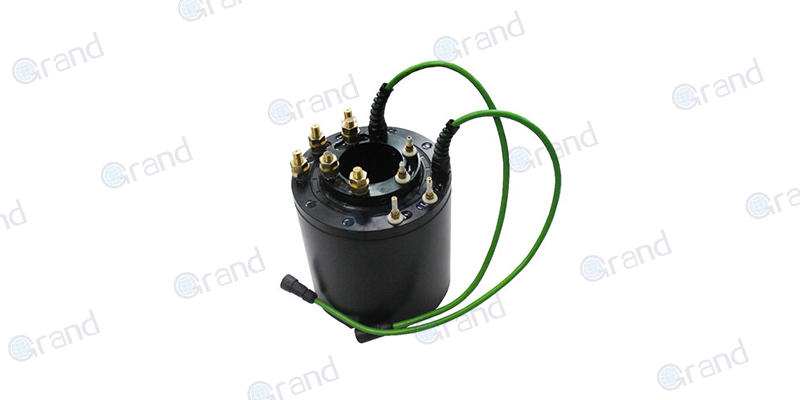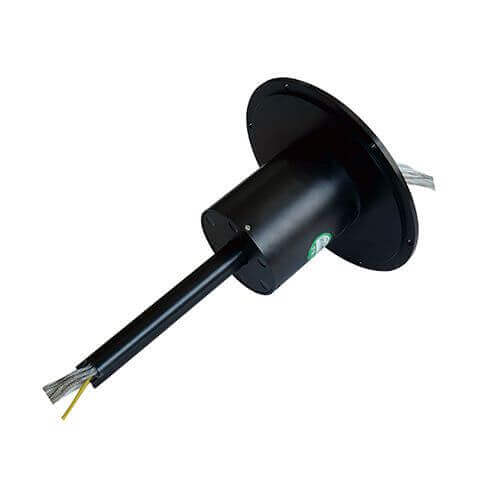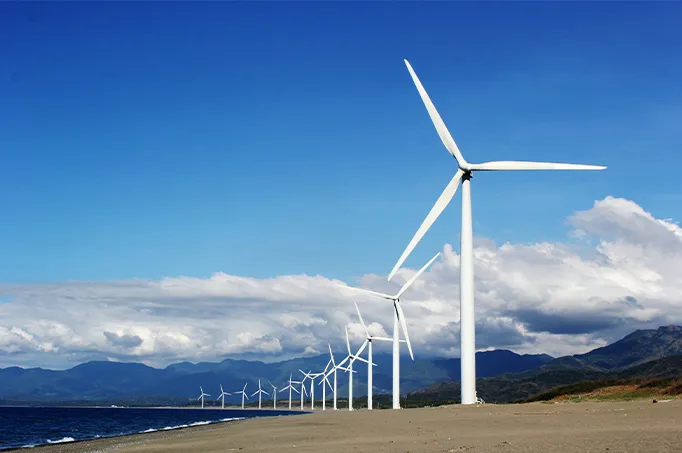In the realm of machinery driven by electric power, a key component that often remains overlooked is the power slip ring. This unassuming device has a critical role, often forming the backbone of electrical power transmission in a wide array of applications. Power slip rings, simply put, are electromechanical devices that facilitate the transmission of power and electrical signals from a stationary part to a rotating part. Essentially, they allow electrical connections to be made and maintained, even in the presence of continuous 360-degree rotation.
The impact and utilization of power slip rings pervade an incredibly broad array of industries. From the smooth operation of colossal wind turbines in the renewable energy sector to the precise motion management in medical imaging devices such as CT scanners, power slip rings prove to be integral to the operation. They are employed in heavy industrial machinery, aiding in maintaining continuous power for rotating devices, and are critical in the defense industry, supporting the seamless operation of advanced radar systems. Furthermore, these devices ensure that everyday conveniences, such as revolving doors and rotating restaurant tables, function without a hitch.
The significance of understanding power slip rings extends beyond a purely academic interest. This knowledge equips engineers, manufacturers, and industry leaders to make better choices in design and application. It optimizes operational efficiency and longevity of equipment, and in many instances, can influence both the financial viability and safety of industrial processes. This article delves into an in-depth exploration of power slip rings, shedding light on their functionality, diversity, maintenance, and anticipated future developments in this field.
Definition and Function of Power Slip Rings
In the realm of electromechanical devices, power slip rings hold a unique and foundational position. At its most rudimentary, a power slip ring can be defined as an electrical connector designed to carry power from a static component to a revolving one. Essentially, it acts like a bridge, linking the stationary and rotating parts of a device or machine and allowing for the uninterrupted transmission of electric power or signals between them.
Understanding the mechanism of a power slip ring starts with recognizing its basic design: a stationary graphite or metal brush – the conductor – making contact with a spinning metal ring. As the metal ring turns, the brush ensures that electrical connections remain stable and consistent. This relatively simple design behavior forms the core functionality of a power slip ring, ensuring a smooth conduit for electrical power to flow from an immobile source to a rotating part.
One might ask: why is continuous transmission of electrical power so vital? The answer to this lies in examining the broader implications of what the discontinuity in power could mean. Imagine a CT Scanner that loses power intermittently every time it rotates or a wind turbine that cannot transmit the power it generates due to its blades’ rotation – situations where intermittent power would equate to catastrophic failure. Power slip rings safeguard against such scenarios, preserving the steady supply of power vital for machine functionality.
The unbroken, continuous transmission of power makes the difference between ineffective equipment and high-efficiency machinery. Therefore, the importance of power slip rings, while not always visibly apparent, is extraordinarily significant, delivering reliable, seamless performance across a plethora of applications.

Types and Components of Power Slip Rings
Despite the common foundational function – the transfer of electric power from stationary to rotating components – diversity arises among power slip rings in terms of configurations. This is due to the variety of needs across different applications, instigating the design and creation of several types of power slip rings.
- Pancake Slip Rings: As their name suggests, these slip rings possess a flat, disc-shaped design, akin to a pancake. The concentric tracks are arranged in a flat plane, and brushes move over these tracks. Their unique design offers compactness in height but may require more radial space. This configuration is preferable when axial length (height) is limited in the mounting space.
- Through-Bore Slip Rings: These slip rings are characterized by a central hole or bore through the ring, which permits the accommodation of additional components such as shafts, cables, or other equipment. If your application requires passing something through the center, like pneumatic or hydraulic lines, a through-bore slip ring would be an excellent solution.
- Capsule Slip Rings: These slip rings are packed into a capsule-like structure, often compact and suitable for systems with limited installation space. In general, these slip rings are used for transmitting low-power signals and are common in video surveillance systems, rotary sensors, and other smaller devices.

Understanding the types of slip rings is only half the equation. To gain a comprehensive view, one must also familiarize oneself with the key components of power slip rings. These typically include:
- Rotor: This is the rotating part of the slip ring. It’s connected to the moving part of the device or machine and rotates along with it.
- Stator: The stator is the stationary part that is connected to the power source. It stays still while the rotor rotates.
- Brushes: Brushes regularly touch the rotor’s surface to ensure electrical connection, providing a continuous transmission path for electrical power or signals.
- Bearings: Bearings are critical components that support the rotor, enabling smooth rotation.
Integrated, these components form the complete power slip ring system. They work harmoniously, each performing their instrumental role, to ensure the unhindered transmission of required power to the revolving sections of a piece of machinery.
Working Principle of Power Slip Rings
Understanding the working principles of a power slip ring is key to appreciating its functionality in numerous applications where steady power transmission between stationary and rotary parts is required. Fundamentally, the operational procedures of power slip rings revolve around a single idea – the continuous transfer of electrical power or signals under rotation.
The working principle of a power slip ring is guided by a set of simple physics principles, particularly those related to the operation of electrical circuits. At its most basic, the power or signal transfer through a slip ring assembly involves mainly three stages, each crucial to the overall functionality.
- Interface Initiation: The first interaction occurs between the stationary component (stator) and the rotating one (rotor) within the power slip ring. The stator, connected to the power or signal source, generates the required electric inputs that need to be transferred. These inputs then flow into the rotor.
- Rotation and Contact: As the rotor spins, it keeps contact with the stationary brushes, which slide over the rotor surface. This interaction is key, as it maintains the electrical continuity necessary for smooth power transmission. This physical contact allows electricity to flow between the stator and the rotating part, ensuring that there is no break in the circuit, regardless of how the machinery moves.
- Power Transfer: As a result of the interactions between the rotor, brushes, and stator, electrical power or signals successfully transfer to the rotating part which is connected to the rotor. This power enables the respective machine or device component to operate effectively.
To sum up, power slip rings serve as powerful ‘rotary electrical interfaces,’ ensuring electrical continuity for rotating machinery. The working principle might seem simple in theory, but it’s what enables the functioning of many complex systems – a testament to the vital utility of power slip rings.
Applications of Power Slip Rings
Power slip rings find their utility in a myriad of applications, owing to their essential functionality – allowing uninterrupted electrical power or signal flow during continuous rotation. Beyond the mechanics and engineering intricacies, it’s imperative to understand their broad-based use in numerous industries.
- Defense Industry: Power slip rings are vital in the defense industry, especially in areas like advanced radar systems. Radars, being inherently rotational devices, need slip rings to transfer power and signals from the stationary part to the rotating antenna. This enables the radar to consistently monitor their environment regardless of the antenna’s constant movement.
- Wind Power Generation: The renewable energy sector, particularly wind power, greatly benefits from slip rings. Wind turbines feature large blades that continuously rotate to generate power – and it’s the power slip rings that facilitate the transfer of this generated power from the rotating blades to the stationary grid system, allowing it to be used elsewhere.
- Heavy Industry: Heavy industrial machines often consist of parts that rotate while performing their tasks. Whether it be cranes, turntables, or even cable reels, the transmission of constant power to these rotating machines is crucial for their operation. This is where power slip rings come in, ensuring continuous power supply no matter how much the equipment rotates.
- Medical Equipment: In the world of medical diagnostics, power slip rings are crucial for the optimal functioning of devices like CT scanners. These scanners depend on continuous rotation while sending and receiving signals for generating images. The slip rings enable this rotation, allowing doctors to get an uninterrupted view of the human body.
- Consumer Devices: Even everyday conveniences, such as rotating restaurant tables or carousels, depend on slip rings for their operations. These devices ensure that while these applications are in motion, they can still receive proper power to function correctly.

These examples provide a snapshot of the sheer diversity of power slip ring applications, demonstrating how they facilitate operational efficacy across various sectors. They underscore the significant role of power slip rings and their impact across various industries.
Factors to Consider When Choosing a Power Slip Ring
Selecting the right power slip ring is crucial in any application to ensure the equipment it supports operates optimally. While understanding its role and functionality is vital, it’s equally critical to know how to identify good quality power slip rings and what factors need to be considered during the selection process.
A good quality power slip ring is generally characterized by a robust and reliable design, providing durability under the harshest conditions. It should offer smooth operation with minimum friction and noise, ensuring the longevity of the device. In addition, it should provide reliable transmission of signals or power, ensuring minimal power loss during transmission.
When it comes to selecting a power slip ring, several factors come into play:
Current Rating: One of the main determinants of which power slip ring to choose is the current rating. Each slip ring is rated to handle a certain amount of current safely, and the one chosen must meet the requirements of the application.
Installation Space: The available space where you plan to install the slip ring also plays a key role in your decision. Each type of slip ring comes in different sizes, and you need to choose a ring that fits in the allocated space. For instance, capsule slip rings have a compact design ideal for installations with limited space, while through-bore slip rings need a central hole for mounting.
Rotational Speed: Different slip rings have different maximum rotating speed limitations. Therefore, it’s crucial to match the slip ring’s speed capacities with the application’s needs.
Operating Environment: The environmental conditions under which the slip ring will operate directly influence the type of slip ring required. Slip rings perform differently under different temperatures, altitudes, and levels of exposure to elements like dust, rain, etc. For harsh conditions, it would be ideal to opt for slip rings explicitly designed to withstand such scenarios.
By considering these aspects, you would be better equipped to choose the most appropriate power slip ring, thereby ensuring the smooth, efficient, and long-lasting operation of your machinery.
Maintenance and Lifespan of Power Slip Rings
Power slip rings are essential components in various applications, consistently facilitating power and signal transfer between stationary and rotating parts. To ensure the equipment they support functions optimally, it’s crucial to maintain and prolong their lifespan. By implementing proper maintenance practices and understanding common issues with power slip rings, one can significantly improve their performance and durability.
Maintenance Practices:
- Regular Inspection: Periodically inspecting the slip ring assembly can help identify potential problems before they escalate. Check for signs of wear and tear, excessive dust accumulation, moisture, or temperature variations, and take appropriate measures to rectify any discovered issues.
- Cleaning: Cleaning the slip ring’s brushes and contact surfaces is essential to maintain optimal performance. The brushes should be free of debris, and the slip ring surface should be clean to ensure good contact. Excessive dirt and contaminants can lead to increased friction, causing wear and tear over time.
- Lubrication: Lubricating the bearings in the slip ring is vital, as they minimize friction between the rotating and stationary components, thereby prolonging the life of the slip ring. Make sure to use a suitable lubricant recommended by the manufacturer.
- Alignments and Adjustments: Regularly check and adjust the brush alignments for proper contact with the slip ring surface. Poor contact can cause inconsistent power or signal transfer and increase wear on the components.
Common Problems and Troubleshooting:
- Power or Signal Interruptions: If there’s an intermittent or complete loss of power or signal transmission, first inspect the brushes and contact surfaces for excessive wear. If required, clean the contact area and ensure the brushes properly contact the slip ring surface.
- Noise and Vibration: If you’re experiencing excessive noise or vibration during the operation of the slip ring, it might be due to misalignments or insufficient lubrication. Adjust the brush alignments to ensure uniform contact with the slip ring surface and make sure the bearings are well-lubricated.
- Temperature Issues: If the slip ring is overheating, it could be due to excess current, friction, or insufficient cooling. Ensure that the slip ring is operating within its specified current rating and that there is proper ventilation around the slip ring assembly.
By adhering to these maintenance and troubleshooting practices, one can effectively increase the lifespan of the power slip rings, allowing the machinery they support to operate consistently, safely, and efficiently.
Latest Trends and Future of Power Slip Rings
As industries and technologies evolve, so does the use and development of power slip rings. Understanding current trends, recent innovations, and future expectations in the power slip ring industry can help users and businesses adapt to the changing landscape. Being aware of these advancements will also provide insights into the influences on efficiency, cost savings, and other factors.
Trends and Innovations:
- Miniaturization: With increasing demands for ever-smaller devices and tools, power slip rings are being designed in more compact sizes. This allows them to meet the requirements of various industries with limited available space, without compromising on performance.
- Materials and Durability: As newer materials with improved wear resistance, electrical conductivity, and durability become available, they are being incorporated into power slip ring designs. This enhances their longevity and reliability, making them more cost-effective in the long term.
- High-speed Operation: With the push for faster and more efficient systems, high-speed power slip rings are being developed to handle the demands of various applications, ranging from aerospace to wind turbines. These innovations result in higher rotation speeds, improved efficiency, and streamlined operations.
- Integration with Additional Technologies: Power slip rings are increasingly being combined with other technologies such as data transmission, fiber optics, pneumatics, and hydraulics to create multifunctional devices that cater to a wider range of application requirements.
Impact on Users:
- Enhanced Efficiency: By incorporating newer technologies, improved materials, and advancements in design, power slip rings can now offer better efficiency in power and signal transmission. This leads to improved operational performance and lower energy loss, benefiting businesses and the environment.
- Cost Savings: As power slip rings evolve, they become more durable and reliable. This translates into longer-lasting components, reducing the need for frequent replacements and downtime. Consequently, users benefit from lower maintenance costs and higher productivity.
- Greater Flexibility: With the integration of multiple technologies into a single power slip ring, users have more versatile solutions at their disposal. This enables businesses to adapt more easily to changing needs, streamlining processes, and allowing for seamless scalability.
- Broadened Application Range: As slip rings become increasingly adaptable to various industries and environments, they open doors to new applications. Thus, businesses can further explore opportunities made possible by cutting-edge power slip ring technologies.
Overall, the rising trends and innovations shaping the power slip ring industry point to a future with more efficient, durable, and versatile systems. By being aware of these advancements, users can make informed decisions and leverage the potential of power slip rings to improve their operations and achieve cost savings.
Conclusion
Power slip rings are indispensable in modern machinery and equipment, enabling the efficient transmission of electrical power in various industries. Understanding their function, types, components, working principles, and applications can help users choose the right power slip ring for their project. As the industry continues to evolve, staying informed on the latest trends and innovations will help users make well-informed decisions.
FAQs about Power Slip Ring
Power slip rings are crucial components in many applications, but their operation and utility can often evoke some common questions and concerns. By addressing these queries effectively, we aim to provide a better understanding, helping users and potential purchasers make informed decisions.
Q: What is a Power Slip Ring?
A: A power slip ring is a device that enables the transmission of electrical power and signals from a stationary part to a rotating part in a system. This is vital in applications where a rotating part requires continuous electrical power or signals for its operation.
Q: What Happens if a Power Slip Ring Malfunctions?
A: If a power slip ring malfunctions, it may lead to intermittent or complete loss of power or signals to the rotating component of the equipment, disrupting its operation. This is why regular maintenance and troubleshooting are essential.
Q: How Can I Extend the Life of a Power Slip Ring?
A: By adopting regular maintenance practices like periodical inspection, cleaning, lubrication, and alignment adjustments, you can significantly extend a power slip ring’s life. Also, using the slip ring within its specified ratings and operating conditions contributes to its longevity.
Q: Can Power Slip Rings Operate in Extreme Conditions?
A: Yes, some power slip rings are designed to operate in extreme conditions like high temperature, high altitude, and harsh weather. However, it’s crucial to select the right type of slip ring that is specifically designed for these conditions.
Q: Are All Power Slip Rings the Same Size?
A: No, power slip rings come in a variety of sizes and forms, each suited to specific applications. It’s essential to consider the available installation space when selecting a power slip ring.
Q: Is a Power Slip Ring the Same as a Connector?
A: While a power slip ring and a connector both enable the transmission of electrical power or signals, they are not the same. A connector allows transmission between two stationary points, whereas a slip ring facilitates transmission between stationary and rotating points.
Q: How Does a Power Slip Ring Work?
A: A power slip ring works by maintaining electrical contact between the brushes and the rotor and stator, allowing the transmission of electrical power and signals between stationary and rotating components.
Q: What Are the Applications of Power Slip Rings?
A: Power slip rings are used in various industries where electrical power and signals need to be transmitted between stationary and rotating components, including wind turbines, packaging machines, medical equipment, robotics, and military equipment.
Q: Can Power Slip Rings Be Used in Harsh Environments?
A: Yes, power slip rings can be designed to operate in harsh environments such as high temperatures, corrosive, and explosive atmospheres. The materials and sealing used in the slip ring construction can be customized to suit specific environmental conditions.
See What We Can Do

